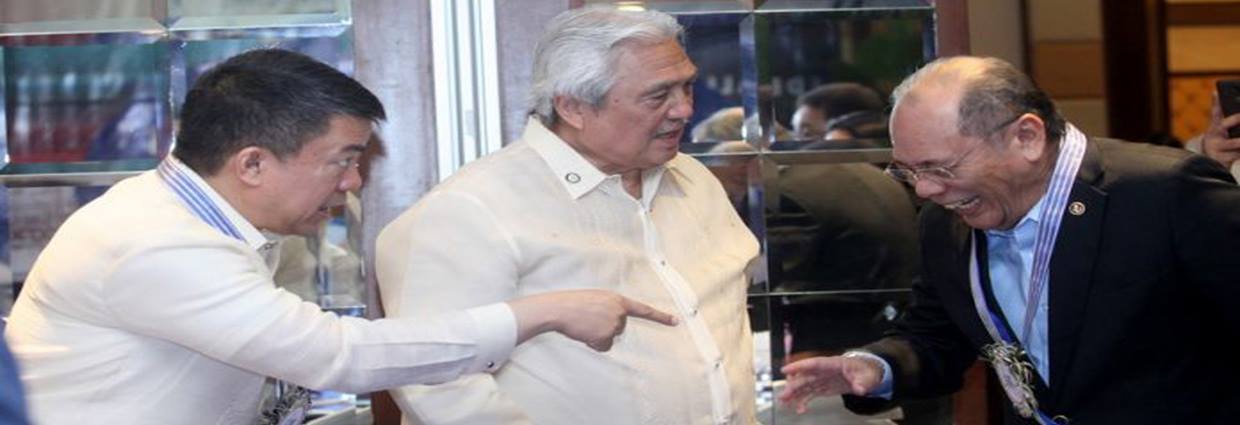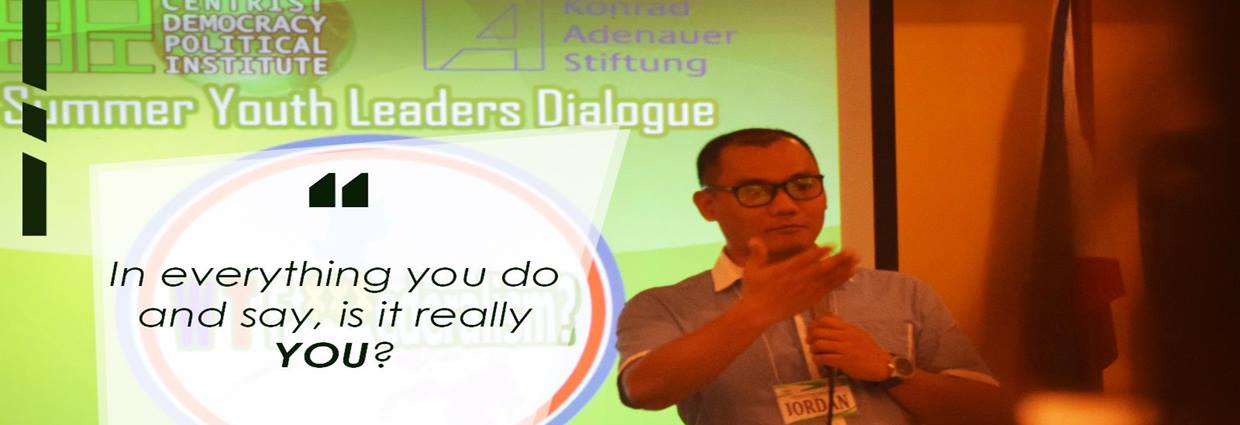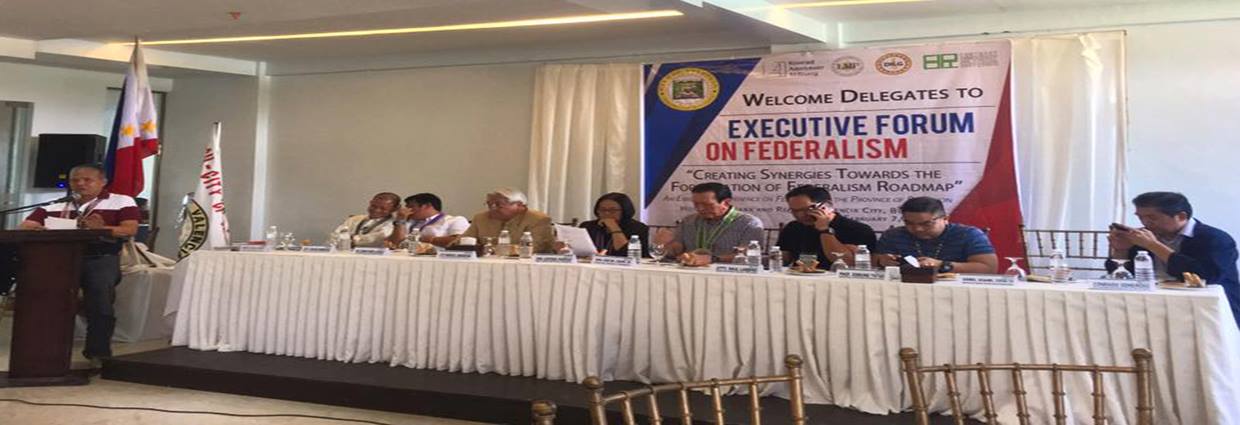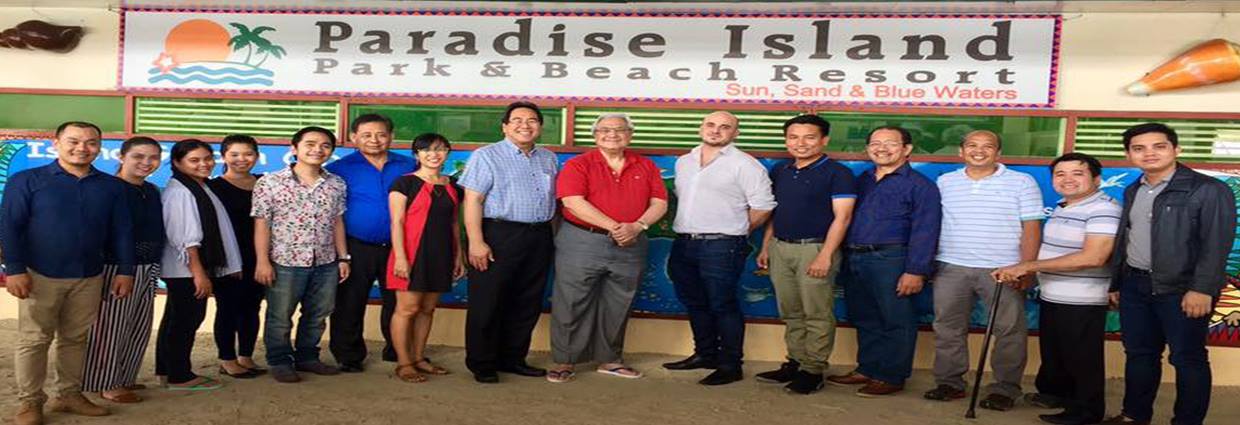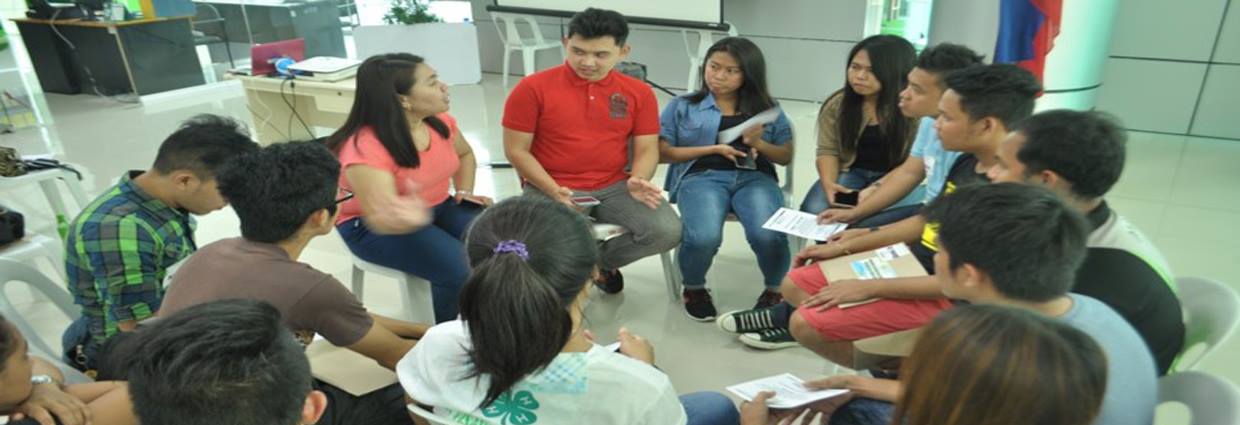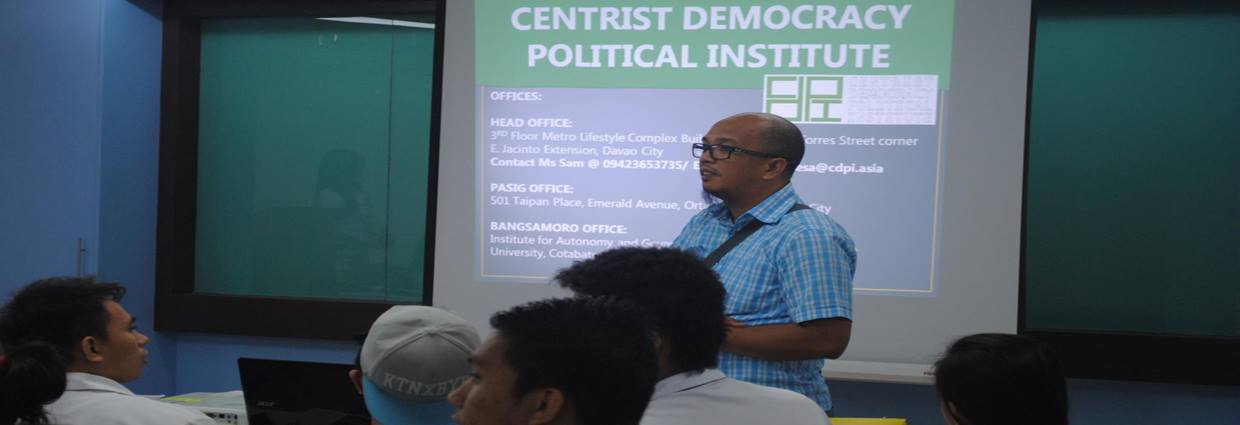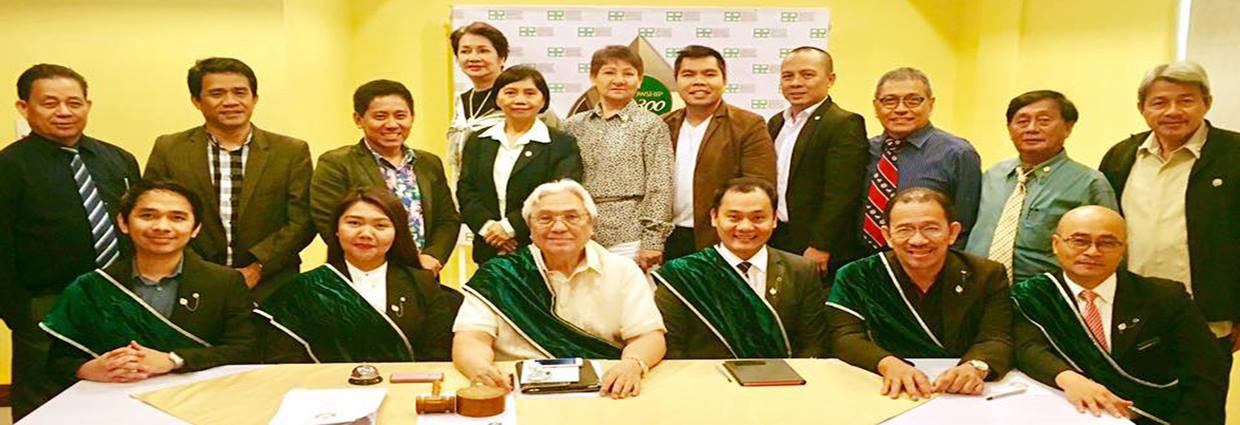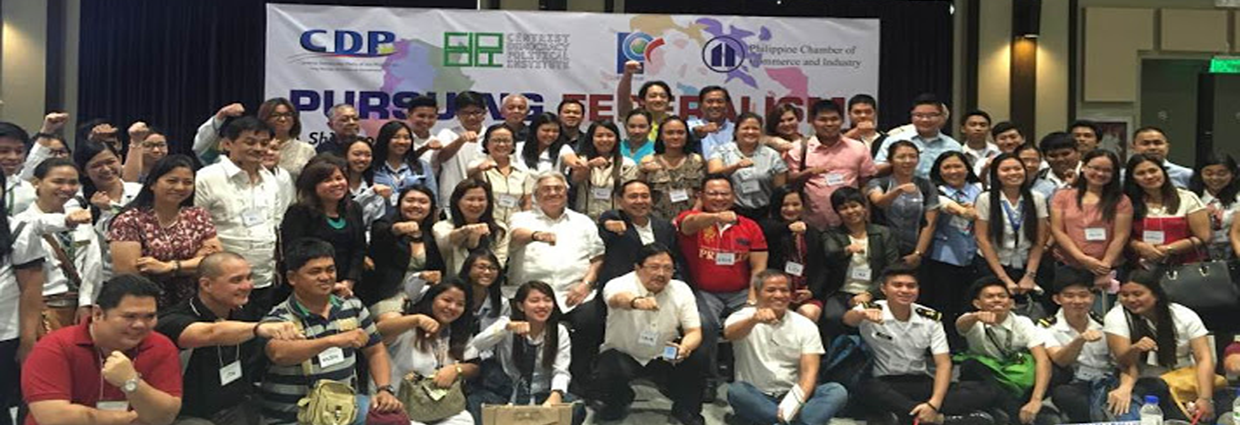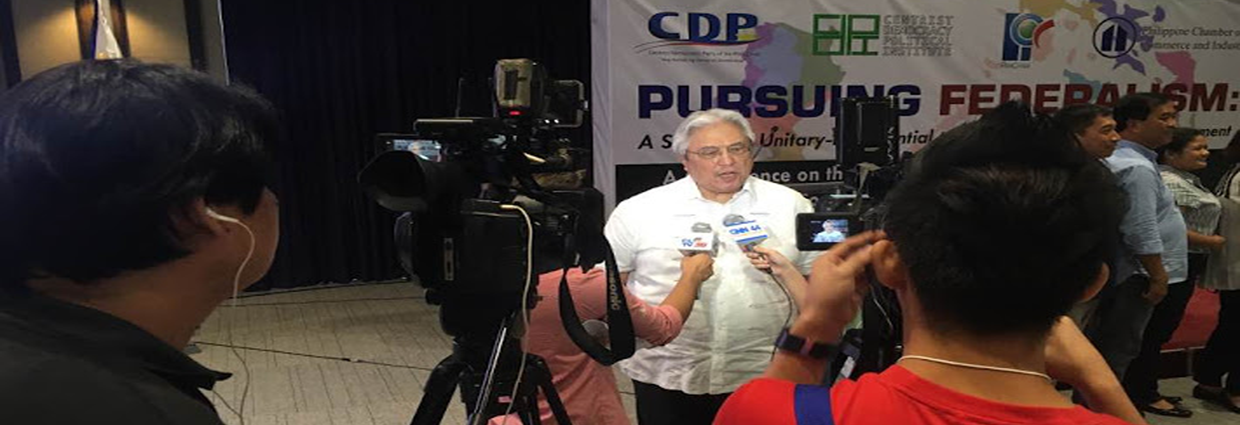Centrist Democracy Political Institute - Items filtered by date: December 2025
Friday, 06 October 2017 11:34
Duterte forms body to probe corruption
President Rodrigo Roa Duterte signed on October 4 Executive Order (EO)No. 43 creating the Presidential Anti-Corruption Commission (PACC) toinvestigate graft and corruption against all presidential appointees in theExecutive Branch.
Created under the Office of the President, the PACC will be composed of aChairman and four Commissioners to be appointed by the President,the majority of whom must be Philippine Bar members and have beenpracticing law for at least five (5) years.
The PACC will also have a Secretariat, to be headed by an Executive Director, who will provide technical and administrative support to the Commission. The personnel of the Secretariat will be appointed by the PACC Chairman.
Further, the Commission may establish their operating units as may be necessary for the performance of its functions and implementation of this EO.
EO No. 43, likewise, outlined the PACC’s powers and functions.
The PACC has the power to hear and investigate administrative cases against all presidential appointees in the Executive Branch for acts or omissions constituting violations of the Anti-Graft and Corrupt Practices Act or Republic Act (RA) No. 3019; RA No. 1379 on the unlawful acquisition of property by a public officer or employee; the Code of Conduct and Ethical Standards for Public Officials and Employees (RA No. 6713); provisions under Title 7, Book 2 of the Revised Penal Code involving crimes committed by public officers; EO No. 292 pertaining to the Administrative Code of 1987; and any rules and regulations duly enforced by competent authorities.
The PACC may also conduct lifestyle checks and fact-finding inquiries of all presidential appointees, including those outside the Executive Branch, and submit its reports and recommendations to the President.
Further, the Commission may investigate presidential appointees in the police and military upon instructions of the President.
“The resignation or retirement of the public officer under investigation shall not divest the Commission of jurisdiction to continue the investigation or hearing thereof,” the EO stated.
In the exercise of its functions, the PACC may engage the help of any law enforcement agency, call upon all government agencies for assistance and cooperation, or employ the services of qualified consultants from the public and private sectors.
Other functions of the PACC include the ability to recommend to the President the issuance of a preventive suspension order, power to administer oaths and issue subpoenas, and endorse vital witnesses into the Witness Protection Program.
“Whenever the Commission deems it warranted and necessary, it may refer any case for appropriate action to the Office of the Ombudsman, or deputize any other office, committee, commission, bureau, agency, department, or instrumentality, including government-owned or -controlled corporations, to conduct a fact-finding investigation,” EO No. 43 said.
Meanwhile, the investigative and recommendatory functions of the defunct Presidential Anti-Graft Commission (PAGC), which were assumed by the Office of the Deputy Executive Secretary for Legal Affairs (ODESLA), will be transferred to the PACC once the members of the Commission and its Secretariat have been duly appointed. (PCOO Content)
Created under the Office of the President, the PACC will be composed of aChairman and four Commissioners to be appointed by the President,the majority of whom must be Philippine Bar members and have beenpracticing law for at least five (5) years.
The PACC will also have a Secretariat, to be headed by an Executive Director, who will provide technical and administrative support to the Commission. The personnel of the Secretariat will be appointed by the PACC Chairman.
Further, the Commission may establish their operating units as may be necessary for the performance of its functions and implementation of this EO.
EO No. 43, likewise, outlined the PACC’s powers and functions.
The PACC has the power to hear and investigate administrative cases against all presidential appointees in the Executive Branch for acts or omissions constituting violations of the Anti-Graft and Corrupt Practices Act or Republic Act (RA) No. 3019; RA No. 1379 on the unlawful acquisition of property by a public officer or employee; the Code of Conduct and Ethical Standards for Public Officials and Employees (RA No. 6713); provisions under Title 7, Book 2 of the Revised Penal Code involving crimes committed by public officers; EO No. 292 pertaining to the Administrative Code of 1987; and any rules and regulations duly enforced by competent authorities.
The PACC may also conduct lifestyle checks and fact-finding inquiries of all presidential appointees, including those outside the Executive Branch, and submit its reports and recommendations to the President.
Further, the Commission may investigate presidential appointees in the police and military upon instructions of the President.
“The resignation or retirement of the public officer under investigation shall not divest the Commission of jurisdiction to continue the investigation or hearing thereof,” the EO stated.
In the exercise of its functions, the PACC may engage the help of any law enforcement agency, call upon all government agencies for assistance and cooperation, or employ the services of qualified consultants from the public and private sectors.
Other functions of the PACC include the ability to recommend to the President the issuance of a preventive suspension order, power to administer oaths and issue subpoenas, and endorse vital witnesses into the Witness Protection Program.
“Whenever the Commission deems it warranted and necessary, it may refer any case for appropriate action to the Office of the Ombudsman, or deputize any other office, committee, commission, bureau, agency, department, or instrumentality, including government-owned or -controlled corporations, to conduct a fact-finding investigation,” EO No. 43 said.
Meanwhile, the investigative and recommendatory functions of the defunct Presidential Anti-Graft Commission (PAGC), which were assumed by the Office of the Deputy Executive Secretary for Legal Affairs (ODESLA), will be transferred to the PACC once the members of the Commission and its Secretariat have been duly appointed. (PCOO Content)
Published in
News
Thursday, 05 October 2017 08:24
A ruthless little bastard
Part 2 – The Gatekeepers
Gerald Ford and Donald Rumsfeld
FORD came into the presidency at the nadir of American global prestige. The US was losing the Vietnam war and Nixon resigned rather than be impeached due to the “Watergate Scandal”. An “accidental president,” Ford retained Nixon’s appointees. Gen. Al Haig, Nixon’s chief of staff who replaced Haldeman, continued in that capacity. This was a disaster in the making as Haig “acted as though he was president, and Ford his understudy”. Ford’s style of management added to this cauldron of complexity as he would govern with a mix of the old Nixon cabinet and some senior aides reporting to him directly—the spokes of the wheel—with him at the center. This free-for-all proved to be disastrous as cabinet members came in and out of the Oval Office with senior aides claiming access time.
It was not long before this configuration collapsed and the whole Oval Office along with it, when Ford, nine months into his presidency, pardoned the former President Nixon “for all offenses against the United States”. His popularity went on a freefall. His office was in disarray. Haig, the holdover, was ineffective as COS. Ford needed his own chief of staff.
Enter the “ruthless little bastard”. This was the description by Nixon of Donald ‘Rummy’ Rumsfeld, Ford’s handpicked COS and erstwhile Ford transition point man. Rummy was one of the more experienced and accomplished bureaucrats in the GOP (Republican Party) firmament. He was “known for his organizational skill and his ‘suffer-no-fools discipline’”(Whipple). He was a Washington insider and understood well the workings of the White House. His appreciation of his job was simple and succinct: “…governing without a chief is the quickest way (for the president) to lose credibility…once credibility (is lost), you can’t govern, so there has to be order, and…I would consider it my job to see that there was order” (Whipple).
The new COS moved in and begun cutting the heads of Ford’s old campaign staff who had sinecures at the White House. Haig was exiled with a new assignment away from Washington as NATO Supreme Commander based in Brussels. Two holdovers from Nixon’s cabinet with great reputation and even greater egos, Kissinger, Secretary of State and Alan Greenspan, Chairman of the Council of Economic Advisers, were the only cabinet members permitted to see Ford alone.
Rummy with his deputy, Richard ‘Dick’ Cheney ran the Oval Office with discipline but it was not enough to arrest the slide of Ford’s popularity brought about by the Nixon pardon. He lost the presidency to Gov. Jimmy Carter, the “peanut farmer” from Georgia.
Jimmy Carter and Hamilton Jordan
The 39th President, Jimmy Carter, came into the White House as the “new kid” on the block. The obvious choice for his COS was Jack Watson, a Washington D.C. insider who could “reach out to the doyennes of Georgetown and mandarins of Foggy Bottom and Capitol Hill”(Whipple). But in the struggle between the presidential transition team headed by Watson and Carter’s campaign staff, all from Georgia, the latter won, with the “primus inter pares” Hamilton Jordan, becoming Carter’s first COS. The architect of Carter’s winning strategy, he was brilliant in catapulting Carter from the “peanut-farmer governor” to the Oval Office. But he was way over his head as COS. He and his team took over the Oval Office “in profound ignorance of their jobs”. His personal life was tattered by scandal (the ‘amaretto and cream’ incident where he spits this drink at a young woman in a bar). The Oval Office was run like a campaign HQ allowing advisers and cabinet members equal access to Carter. The end for Jordan as COS came a few months after the infamous siege on the American embassy in Tehran, Iran, where 66 hostages were seized and kept for 444 days – up to the time Carter lost to Ronald Reagan, in the election of 1980.
The Philippine context
Malacañang does not have the classic American concept of chief of staff (COS). The closest to the office could perhaps be the Executive Secretary, the highest-ranking official in the Office of the President.
Both Philippine ES and American COS claim pre-eminence in the hierarchy of their respective executive offices. This is based on a political reality: access to the president. It imbues the person who occupies the office with a fragment of that imperium exclusive only to the presidency.
In our political life, especially in the highest echelons of governance, power is the main currency; and the president has copious amounts of it to dispense, but frugally. The ES/COS must see to it that it is done so.
This is why in the Philippines the Executive Secretary is known as the “little president”. By definition, his mandate is “to directly assist the President in the management of affairs of the government as well as to direct the operations of the Executive Office”. But the reality on the ground seems to be different. Titles and mandates are of little consequence to the Deegong.
From the beginning of his term, the President has apparently been acting as his own chief of staff with his Special Assistant to the President (SAP) Christopher ‘Bong’ Go, ever constantly at his beck and call, seldom leaving his side. If as the saying goes, “access to the presidency is power itself,” Bong Go could be the most powerful bureaucrat in government. But, with the propensity of the populist president to be accessible to all, and Go’s own admission that he receives from 500 to 1,000 texts daily and numerous calls, he could be the most harassed bureaucrat in government. We doubt that the SAP has the time or the inclination to pre-process policies that need DU30’s attention—a prime duty of a COS.
An internal mechanism may have been arrived at that includes the ES, ‘Bingbong’ Medialdea as the chiefpraetorian that guards the portals to the presidency.
The Deegong has been described as an alpha male, a superb local politician, trustful only of old friends, classmates and a coterie of bureaucrats in the uniformed services. He tends to dominate and intimidate. This is the nature of the beast, and perhaps these are the alter egos he is comfortable with in running this government. Or perhaps, the models described by Whipple in his book may not work in the Philippine context. The Deegong may not need to hire his own bastard. He already is one!
But this government could collapse given that the greater burden of responsibilities lie almost solely on the shoulder of this “73-year old millennial” passionately driven to offer the coming generations of Filipinos a shot at a better future by being the chief architect of a systemic and structural change.
And with all his magnificent faults and scarce virtues, this is the type of leader that this country needs today. His 80 percent approval rating is his constituents’ imprimatur.
(Next week: Part 3 – “One hell of a chief of staff”: Ronald Reagan and James Baker III; lessons from the gatekeepers that are universally applicable)
Published in
LML Polettiques
Thursday, 05 October 2017 07:26
Gov’t working double-time to make PHL more attractive to investors–Dominguez
SHANGHAI—Finance Secretary Carlos Dominguez III has cited the government’s continuing efforts to open the economy to foreign participation, the country’s political stability and its young, dynamic workforce as among the key factors that would make the Philippines far more attractive to foreign investors.
Dominguez said the Duterte administration’s unprecedented spending on infrastructure to enable the Philippines to catch up with its Southeast Asian neighbors would also encourage more foreign investors to infuse fresh capital into the country.
Among these factors, the government is also currently reviewing its Foreign Investment Negative List (FINL) to increase the number of areas for 100 percent foreign participation, Dominguez said at a briefing on the Philippine economy here when asked what would make the country more attractive to Chinese investors.
“We have stable policies, we honor our contracts, and we have a young, growing population getting richer and very hardworking,” said Dominguez before Chinese business leaders at the forum organized by the Bank of China.
“There are many opportunities in the Philippines for a partnership with Chinese technology, Chinese know-how, some capital from Chinese enterprises, and we welcome joint ventures and investments from abroad,” Dominguez said.
Dominguez has consistently cited the Philippines as being in a “demographic sweet spot,” in which millions of young, smart, hardworking Filipinos are about to enter the global workforce at a time when the populations of some of the mature economies in Asia begin to age.
As for the FINL, Dominguez has said in earlier forums that he favors lifting the foreign ownership limits for certain sectors of the economy to generate more foreign investments, except for land.
The other Philippine government officials with Dominguez at the Philippine economic briefing were Secretaries Ernesto Pernia of the National Economic and Development Authority (NEDA), Benjamin Diokno of the Department of Budget and Management (DBM), and Bangko Sentral ng Pilipinas Governor Nestor Espenilla Jr.
Pernia, for his part, said during the forum that “the Philippines has become an amazing investment destination,” while Diokno said investors are most welcome in “the fastest growing country in the fastest-growing region in the world.”
Espenilla, meanwhile, cited the country’s financial stability characterized by its low inflation and low-interest rate environment.
Dominguez also said the Philippines plans to “test the debt market” in China by issuing renminbi-denominated Panda bonds by around November this year.
“We are very happy that the Bank of China has come to our assistance. It’s a small issue—the first baby step we are issuing—a $200 million bond by around November of this year. This will be the first of many in the future,” Dominguez told Chinese businessmen at the forum.
The economic team proceeded here after meeting with Chinese commerce ministry officials in Beijing to, among others, hold a “non-deal” roadshow for the Philippines’ planned Panda bond issue.
The Philippine government is currently in the process of securing the necessary approvals and fulfilling the requirements to tap China’s bond market—largest among Asia’s emerging economies.’
Earlier, Dominguez assured China of the Philippines’ full cooperation with the Asian Infrastructure Investment Bank (AIIB) and the Belt and Road program, both of which, he said, will “bring lasting benefits to all countries of this region” as these “will set the conditions for more comprehensive trade” in this part of the world.
Dominguez has also thanked China for its generosity in supporting the Duterte administration’s ambitious infrastructure modernization program, noting that “over the past few years, we have developed numerous bilateral mechanisms that will allow closer coordination between our two countries across a broad range of issues and concerns.”
Given the “great strides” that have been achieved towards building a common market among the Philippines and the other member-economies of the Association of Southeast Asian Nations (ASEAN), which will create a large enough market to make their industries achieve economies of scale, Dominguez said the Philippine economy can “perform as a gateway to a very large and increasingly prosperous Southeast Asian regional market.”
Dominguez also said he believes the comprehensive cooperation between the Philippines in China, while currently only in its early stages, will “function as a driver of growth in the region” over the next decade. (DOF)
Published in
News
Tuesday, 03 October 2017 11:39
CHA-CHA EXPRESS GATHERING STEAM
Political popularity gives heft to machinery. Impatient with the Palace’s pace, House leaders have seized the initiative to make a constituent assembly (Con-ass) possible soon. Proposals are getting clearer, with a Palace-sponsored proposal, a party plan, bills for scheduling and a draft Constitution on the table. Two of these proposals converge on harnessing President Duterte’s popularity to accomplish the transition to a new system.
Published in
News
Tuesday, 03 October 2017 09:16
Government assures enough resources for IDPs amid extension of Marawi conflict
The government assured Monday, October 2, that there will be sufficient resources for internally displaced persons (IDPs) in Lanao del Sur despite failure of military to reach its target to liberate Marawi on September 30.
Task Force Bangon Marawi Spokesperson Kristoffer James Purisima said relief assistance to IDPs continues and it will not stop even if the fighting ends.
“We’re prepared to stretch our resources and to augment our resources as needed,” said Purisima during the regular Mindanao Hour press briefing in Malacañan.
“Hindi tayo titigil kahit tumagal pa o malapit ng matapos ang kaguluhan sa Marawi ‘no. Hindi natin ito tinitingnan basta patuloy ang ating focus sa ating mga IDPs,” he added.
He noted the continuous construction of transitional shelters to provide IDPs with comfortable dwellings as soon as possible.
“Basta may matapos ng significant number of transitional shelters, ita-transfer na natin sila palabas ng evacuation centers papunta doon sa transitional shelter site,” said Purisima.
He said the National Housing Authority is “on target” to finish the first portion of the project, which include 1,500 transitional shelters.
Defense Secretary Delfin Lorenzana earlier said the battle in Marawi might end on September 30. However, ground commanders said the conflict might extend for 10 to 15 days due to difficulty in neutralizing the remaining Maute terrorists, who spread themselves thinly within their main stronghold.
Purisima, meanwhile, said the government continues to provide trainings and livelihood for IDPs to help them recover from the Marawi siege.
Psychosocial intervention like art and play therapy, and health intervention such as water, sanitation, and hygiene services are also being conducted for the moral and psychosocial recuperation of the displaced Marawi residents.
IDPs likewise continue to get relief supplies consist of hygiene kits, clothing, food and slippers from government and other non-governmental organizations.
In an interview after Purisima, Presidential Spokesperson Ernesto Abella cited the first mass held at Saint Mary’s Cathedral in Marawi on October 1 (Sunday) noting that it was a welcome development in the government’s tenacity to liberate the Islamic city.
“Saint Mary’s Cathedral had been damaged during the siege of the city; and the terrorist group posted propaganda video of their desecration of the cathedral’s religious images. The Cathedral was retaken by government troops after 95 days of fighting and yesterday’s celebration of the Mass was a welcome development in the push to totally liberate Marawi from extremists, and restore normalcy to the lives of its residents,” he said.
“We call on all Filipinos to pray for our soldiers, displaced residents; and that we might continue to respect and live with each other peacefully,” he added.
Abella also commented on the support of the American Chamber for the tax reform program hoping that the Chamber and other business groups will also agree that the final tax reform bill to be approved by Congress will deliver all revenues needed to fund the President’s agenda for ambitious investments.
“Without these revenues, we would have to incur even more debt to finance our economic growth agenda, thereby endangering our investment grade rating, raising our borrowing cost and limiting our access to financial markets,” the Palace spokesman said.
Abella, meanwhile, condemned the fresh attacks of New People’s Army (NPA) in Sarangani, South Cotabato, Surigao del Sur, Palawan and Masbate saying that their recent action “fuels the public’s doubt” about the group’s sincerity to talk peace.
The NPA reportedly abducted a tribe leader and a CAFGU member in Surigao del Sur, ambushed a military convoy in Palawan and killed a policeman in Masbate.
“The government will undertake appropriate steps to deal decisively with these forces that seem to have lost their sense of nation-building,” he said.
Abella also gave his comment on the call for the ouster of the Philippines from the United Nations Human Rights Council saying: “We respect the rights of all, including the extremely critical, to freely express their opinion of the government.”
“However, self-styled watchdogs of the Philippines’ human rights performance need to balance their call with legitimate organizations like the United Nations Human Right Council (UNHRC), which recognizes the work the Philippines does, given and despite its challenges,” he said.
“The UN body’s unanimous adoption of its report on its review of the Philippines last month, highlighted the Philippines’ clarification of issues brought against it by local interest groups; as well as the Philippine government’s own recommendations on how the UNHRC can further strengthen its review processes in succeeding cycles. Having said that, the Philippines, as an active member of the UNHRC and respects this body’s integrity, and will call out attempts to use it seemingly to advance certain interests and political agenda,” he added. (PND)
Published in
News
Thursday, 28 September 2017 09:35
The President needs his own bastard
Part 1 – The Gatekeepers
WHILE browsing at Barnes & Noble along Union Square in New York last July, I came across several books that I brought home with me to fill my summer days. One was by Chris Whipple, a documentary filmmaker, a journalist and a multi-awarded producer at CBS’ “60 Minutes”. The book, The Gatekeepers, a non-fiction political work describing nine American presidencies from Richard Nixon’s to Barack Obama’s. But the interesting part is that the focus is on their chiefs of staff (COS), from Nixon’s H.R. Haldeman to Obama’s first COS Rahm Emmanuel to his fourth, Denis McDonough. Due to space limitations, article, I will describe only the first presidency, that of Richard Nixon and two or three in subsequent articles. Students of Philippine presidential politics—and I count myself among the enthusiastic ones—can perhaps extract some analogous practices on the workings of the American executive office that we can improve on.
The subtitle of the book is “How the White House Chiefs of Staff Define Every Presidency”. This is of course just one facet of the American presidency, or any presidency for that matter. The Philippine presidency can be more complicated and multi-dimensional than what could be circumscribed through the workings of the chiefs of staffs. On the other hand, the president, through his/her choice or non-choice of a COS could also define this particular office; and in so doing, also characterizes and demarcates the presidency. With that, the relationship is a symbiotic one.
I may be tempted from time to time to compare the Philippine experience with that of America, but I must confess I don’t have enough intimate knowledge of the current administration to validate Whipple’s thesis.
The birth of the modern American COS, “a gatekeeper” was during the time of President Dwight ‘Ike’ Eisenhower. A former New Hampshire governor and a friend, Sherman Adams, was the first COS and, according to Whipple, “[wielded]as much power as his boss”. Fiercely loyal, selfless and protective of his principal, he was in the mold of what Eisenhower had been used to: army chiefs of staff. These were the professional subalterns that contributed in no in small ways to the triumph of Eisenhower’s armies in Europe during WW2.
Nixon and Haldeman
Whipple’s study really started in depth with Richard Nixon who lost to John F. Kennedy. Nixon came into office learning from Ike the need for a strong COS and the failure of his presidential adversary. Kennedy decided he would be his own gatekeeper and allowed several senior aides to have access to him, the “spokes of the wheel”; until ill-advised by the same into sending mercenaries into Castro’s Cuba, into what was now known as the “Bay of Pigs” fiasco.
This was an experience Nixon tried to avoid; and thus, the entrance of H.R.’Bob’ Haldeman, Nixon’s “Lord High Commissioner,” his COS. Nixon was a flawed man and a paranoid out to exact revenge on his political enemies; among others, his predecessor Lyndon B. Johnson, the Kennedys and the press. The Democrats started the Vietnam war and LBJ was driven from office a broken man. Nixon wanted to end the war – at all costs.
As Nixon’s COS Haldeman understood very well that “the president’s time is his most valuable asset” and he devised a staff system that became a template for subsequent administrations. He defined the job of those that serve the President in the executive office as one that is “not to do the work of government, but to get the work out to where it belongs – out to the departments. Nothing goes to the president that is not completely staffed out first…” He did not permit someone to meet with the president privately with an agenda without going through the COS. The president’s time is best used to make decision himself and not to preside over the decision-making process of the staff. The quality of a good COS and his immediate deputies and staff is the farming of what are major considerations to the president. Minor ones are the staff to decide upon.
But this almost total control of the COS of the executive office could not prevent minor functionaries from acting on their own that led to the break-in of the Democratic National Committee, the infamous “Watergate scandal” that sank the Nixon presidency. There was no clear proof that Nixon and Haldeman approved the original break-in; but they both were deep in the cover-up of the crime.
Whipple writes that“…faced with this ultimate crisis, Haldeman failed to execute his own model of White House governance. Haldeman, the COS, was at the center of it”. Rumsfeld, the COS of President Ford later declared: “I don’t doubt for a minute that Haldeman executed the president’s desires well – maybe too well…I don’t think Haldeman ever said ’No, you’re wrong’. He was dutiful.”
Looking back, it was hubris that proved to be the dagger through the heart of the Nixon Presidency. The chief of staff needed to be anchored in a modicum of ethics and moral behavior. That could be his ultimate guarantee to protect the office of the presidency. He did not possess these.
The Philippine context
The Deegong’s presidency so far has been defined positively by its supporters, adherents and fanatics mostly in the alternative social media. But the negativity oozes out from the conservative traditional mass media. Confronted by this unorthodox outsider, they are conflicted and oftentimes outright hostile. The fallout from this cynicism, mostly self-inflicted, could have been averted if the persona of the PRRD were not exposed so often to public scrutiny. The talking heads of the administration are no match to counter and deflect the attacks of the well-funded and long entrenched apparatus of the oligarchy and the old political order. The bureaucracy’s concerted efforts are not visible and therefore ineffective. This could be attributable to the President himself. His pronouncements which have the force of official policies are not well pre-processed, which lay himself bare to contradictions from his own cabinet and subalterns. The President is a singularly driven man, an alpha male who tends to dominate. From a political management viewpoint, deadlier is the perception that the presidency is in a disarray.
The Deegong is an excellent parochial politician suddenly thrust into the rarified air of national prominence and global politics. His mistake perhaps is in surrounding himself with similarly situated advisers—outsiders, naïve to the arcana of national politics, perforce elevating them to their level of incompetence. Thankfully many of them have grown in stature and some jettisoned by the PRRD himself. After 15 months of what is perceived to be an experimentation, trial and error and learning process of a journey from the periphery to the center, it’s time for a drastic overhaul and an upgrade.
He needs an alter ego that must shape his executive office to hew as close as possible to his persona, enabling the office to push for his agenda but must fulfill too the need for a visible presidency, a critical ingredient for good governance. He needs a good chief of staff, his heat shield, or in more pedestrian language, “his ruthless little bastard”.
Next week: Part 2 – ‘
A ruthless little bastard’
Published in
LML Polettiques
Wednesday, 27 September 2017 14:23
Lorenzana explains CDPI proposal to shift to federal system of gov’t
The Centrist Democracy Political Institute (CDPI) headed a former Cabinet official from Davao City has begun explaining its proposal for the country to shift to a federal parliamentary system, urging Congress to start deliberating the amendments in 1987 Constitution that will pave the way for federalization.
Lito Monico Lorenzana, President of the CDPI, told reporters and editors covering Kapehan sa Dabaw at the SM Annex at Ecoland last Monday morning the CDPI, one of the four groups espousing federalism will be presenting this proposal to the 25-man commission to be appointed by President Rodrigo Duterte.
CDPI is a political non-profit organization, in partnership with Konrad Adanauer Stiftung Philippines, a German political foundation which promotes political education initiatives worldwide.
“We want a system where power and authority are not centralized but shared between the federal government and the states --- we call these regions, sub-states,” Lorenzana said in an earlier press briefing in Malacañan.
“We have several models of federalism already submitted to the Congress. We are presenting to you today a model borne out of years of discernment and study,” according to Lorenzana.
According to Lorenzana, the CDPI’s proposal adopted and updated the 2005 Consultative Commission documents which they call, “The Centrist Proposal.”
“In our proposal, the Centrist Proposal, the legislative and the executive are fused…We fuse them in a unicameral parliament, one body. And the head of government is the Prime Minister --- with his Cabinet recruited among members of Parliament,” Lorenzana said.
He said the President, as head of state, shall be elected from among the members of parliament and shall have a five-year term while the Prime Minister or the head of government will have no term limits but can be booted out of office through a vote of no confidence, not through the process of impeachment.
Lorenzana said the CDPI has four preconditions while revising the 1987 Constitution: political party reform, enactment of a law banning political dynasties; the passage of a real all-encompassing Freedom of Information Act; and electoral reforms.
“We penalize turncoatism or the switching of political parties, the balimbings, the political butterflies,” Lorenzana said.
As for electoral reforms, he said the Commission on Elections (COMELEC) must be reformed to remove all quasi-judicial work and transfer electoral contests and protests to the judiciary.
“These four conditions have a high probability of passage while we have a President endowed with tremendous political capital and have the political will to act decisively,” he said.
Lorenzana said the CDPI has also proposed timelines, which urges Congress to start deliberating amendments in the 1987 Constitution from October this year up to February 2019.
The second stage will be from May 2020 to 2025, wherein the first parliamentary elections under the new federal Constitution shall be conducted not later than May 2020 “to organize the first parliament under the newly-ratified Constitution with a term of five years up to 2025.”
From May 2025 to 2030, the second regular parliamentary elections under the new Constitution shall be held by 2025 with a five year term to 2030. The country will then have a new Prime Minister and a new President, he said.
“That is the shift to parliamentary…But the process of federalization goes on,” Lorenzana said the Centrist Position calls for 11 autonomous territories.
The 12th autonomous territory, the Bangsamoro, will be constituted ahead of the Bangsamoro Basic Law enacted by Congress previous to the plebiscite, Lorenzana said.
Lorenzana said that by 2028, autonomous territories may already operate like federal states. “They can raise their own funds. They can come up with their own resources. They can come up with their own taxes and spend for themselves. It is a kind of federalism we aspire for where the people from cities and regions shall negotiate among themselves and arrive a decision to set up their own federal state,” he said.
Lorenzana said the process of shifting to federal type of government may take some time, and would need massive political education, especially among millennials. “The Centrist roadmap to federalism is designed to mitigate a shock to the body politic arising from the purging of traditional political parties to the immediate passage of reform laws, now pending in Congress,” he said. (with PNA reports)
Published in
News
Wednesday, 27 September 2017 10:10
PH up one spot in WEF Global Competitiveness Report
MANILA — The Philippines has improved its ranking in the World Economic Forum (WEF) Global Competitiveness Report 2017-2018, placing 56th out of 137 economies in the latest report released Wednesday.
The country’s ranking inched up from rank 57 in last year’s WEF report.
It was noted that the country had biggest gains in pillars of higher education and training, up by three notches from the 2016 rankings; labor market efficiency, up by four notches; and market size, up by four notches.
“It is good to see that we have maintained our overall competitiveness and even moved one notch higher,” said Makati Business Club (MBC) chairman Edgar Chua in a statement.
From 2012 to 2017 reports, the Philippines landed its best ranking in 2015 at 47th spot.
It ranked 65th in 2012, 59th in 2013, and 52nd in 2014.
However, the Philippines’ rankings in ASEAN declined by two spots as Brunei Darussalam and Vietnam climbed in the Global Competitiveness Index.
From being in the top five among ASEAN member states in 2016, the country’s ranking fell to rank seven.
Brunei Darussalam’s global ranking in 2016 was at 58th spot while Vietnam was at 60th. Brunei Darussalam and Vietnam’s rankings improved to 46th and 55th spots in the 2017 report, respectively.
“The state of Philippine infrastructure is in dire need of attention and action. While the quality of air transport infrastructure was identified as one of the country’s greatest disadvantages, ranking 124th out of 137 countries, the quality of other infrastructure such as roads and ports stand as big disadvantages, as well,” Chua said.
“In fact, we trail behind our ASEAN neighbors in almost all measures of infrastructure. We ranked lowest in ASEAN in terms of quality of overall infrastructure, in quality of roads, and in quality of air transport infrastructure,” he added.
The MBC official noted that implementing plans of the Duterte administration’s Build, Build, Build program will be vital to make the Philippine economy more competitive.
Moreover, other ASEAN countries’ rankings in the Global Competitiveness Report for this year are: Singapore at 3rd spot; Malaysia at 23rd spot; Thailand at 32nd spot; Indonesia at 36th spot; Cambodia at 94th spot; and Lao PDR at 98th spot.
For the global rankings, the 10 most competitive economies worldwide in the WEF 2017 report are Switzerland, United States, Singapore, Netherlands, Germany, Hong Kong, Sweden, United Kingdom, Japan, and Finland. (Kris Crismundo/PNA)
Published in
News
Tuesday, 26 September 2017 14:39
ADB says PPP initiative to bridge infra gap in PHL, Asia
The public-private partnership (PPP) initiative has the potential to bridge the infrastructure gap in the Philippines and Asia at large, the Asian Development Bank (ADB) said on Tuesday.
"PPPs, if done right, have the potential to fill the region's huge infrastructure needs, leveraging the capabilities and resources of the private sector towards the common goal of sustainable development for all," ADB chief economist Yasuki Sawada said in a statement.
ADB principal country specialist for the Philippines Joven Balbosa noted the country should look at PPPs as a long-term investment.
"The last administration put up a PPP Center equipped with a very strong staff ... This administration utilized that more fully by looking at the optimal mix," he said.
The country needs $15 billion to finance infrastructure projects until 2030, with several PPP projects in the pipeline, Budget Secretary Benjamin M. Diokno earlier said.
Diokno said the government will focus on doing "hybrid" public-private partnership projects—choose the project, look for financing, and let the private sector build it.
"There are lots of opportunities," Diokno said in April, when asked about the opportunities for the private sector.
Under the build-operate-transfer scheme, the private sector builds the project and then manages and operates it for a certain period before it is turned over to the government.
Asked to comment on this, ADB Philippines country manager Richard Bolt said they see it more as a "rebalancing."
"We don't see it as a bias. They're looking at all modes to do this construction. They're looking at a mix. It is the beginning of a rebalance," he said. — VDS, GMA News
Published in
News
Monday, 25 September 2017 10:50
PH thanks Saudi for extending amnesty to undocumented OFWs
MANILA — The Philippines on Sunday expressed its appreciation to Saudi Arabia for extending an amnesty program that would allow thousands more of undocumented Filipinos in the kingdom to go home.
Department of Foreign Affairs (DFA) Secretary Alan Peter S. Cayetano said the extension of the amnesty program was expected to benefit more than 6,000 undocumented Filipinos who were not able to avail themselves of the initial amnesty offer.
A total of 8,467 undocumented Filipinos availed themselves of the initial amnesty offer and were repatriated in various batches by the DFA.
“We really appreciate this gesture of the Saudi government that would allow us to bring home many more of our kababayans (countrymen) who are still stranded there,” he said in a statement.
The DFA chief personally conveyed Manila’s appreciation to Saudi Foreign Minister Adel Al-Jubeir on the sides of the 72nd United Nations General Assembly in New York on Saturday.
“The Philippine government would like to thank you very much for the extension of your amnesty program,” Cayetano told Minister Al-Jubeir after the latter delivered his country’s statement before the General Assembly.
Foreign Affairs Undersecretary for Migrant Workers Affairs Sarah Lou Arriola said the extension was in response to the request of the Philippines and several other countries for an extension of the amnesty program that began March 29 this year. (Leslie Gatpolintan/PNA)
Published in
News

